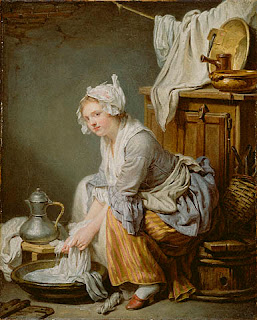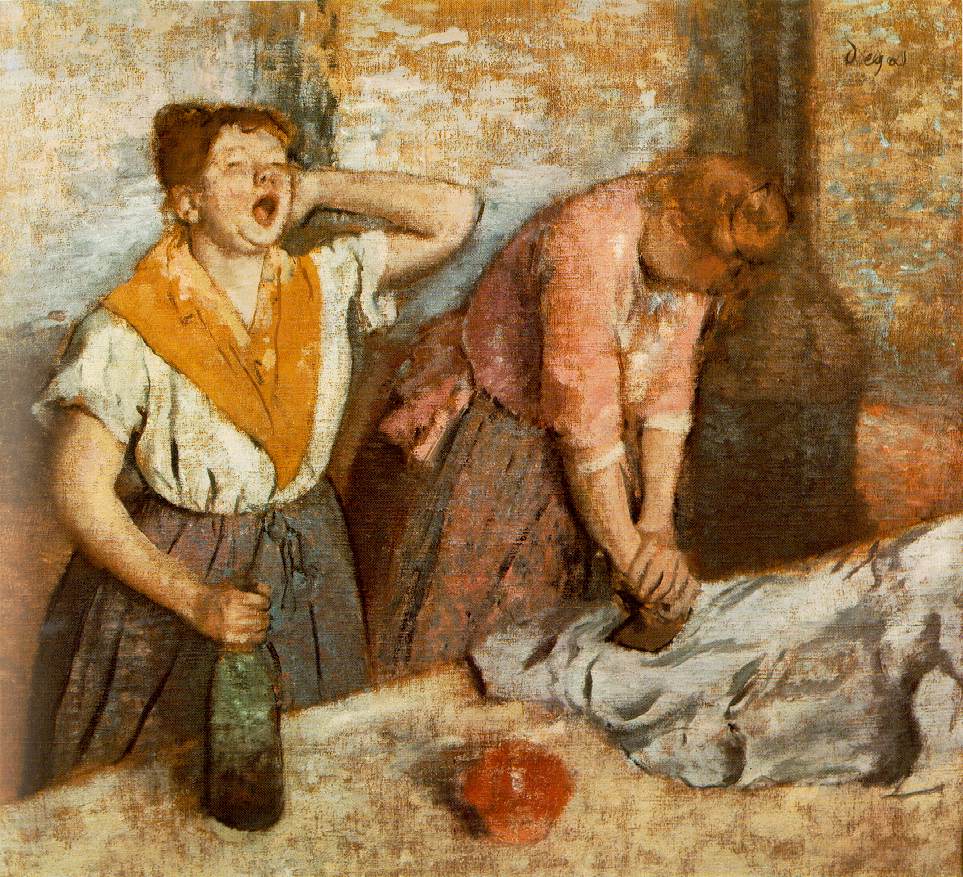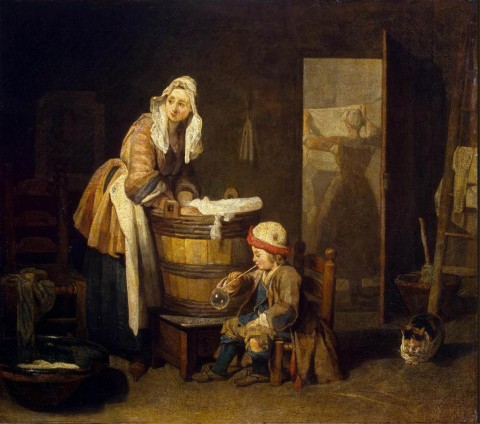Wednesday, May 6th, 2009
Washer Women
I think everyone has some kind of dream in which their worst fears are realized. Apparently, my worst fear revolves around being unprepared to teach an art history lecture. Last night, I dreamed that I went to go visit my past professors at my alma mater. It was the first day of summer term, and I discovered upon arrival that I was slated to teach a course that began that very afternoon! The title of the course seminar was “Washer Women in Art,” and it was supposed to cover all the extant depictions of laundresses. I started to scramble around campus, trying to find materials for the class, but I couldn’t think of any paintings to include in the slide list. I kept thinking, “I can’t think of any paintings of washer women,” and “If any paintings exist, they probably are Dutch from the 17th century.”
Needless to say, I woke up in a panic.
Naturally, I had to find out today if there are any paintings of laundresses. And there are. A lot. (Though not really any Dutch ones from 17th century, much to my subconscious’ chagrin!) Here are a couple of my favorites:
This book points out how the laundress does not wear a hoop skirt or any other fashionable clothing of the Rococo period – Chardin was interested in painting the domestic life of an ordinary French woman.
 Greuze, The Laundress, 1761
Greuze, The Laundress, 1761
Denis Diederot said of the laundress in this painting, “She’s a rascal I wouldn’t trust an inch.” The Getty has published a whole book about this painting, comparing this provocative laundress to other paintings of laundresses by Greuze.
 Camille Pissarro, Washer Woman, 1880
Camille Pissarro, Washer Woman, 1880
 Martin Driscoll, The Washer Woman. I was not familiar with this contemporary artist before my quest to find laundress paintings, but I think this work is very nice. You can look at more of Driscoll’s paintings on his website. (Thanks to the Anne P, I also learned that this painting is inspired by William Orpen’s “The Wash House” (1905) located at the National Gallery of Ireland.)
Martin Driscoll, The Washer Woman. I was not familiar with this contemporary artist before my quest to find laundress paintings, but I think this work is very nice. You can look at more of Driscoll’s paintings on his website. (Thanks to the Anne P, I also learned that this painting is inspired by William Orpen’s “The Wash House” (1905) located at the National Gallery of Ireland.)
 Degas, Laundresses Carrying Linen in Town, c. 1876-78
Degas, Laundresses Carrying Linen in Town, c. 1876-78
 Degas, Women Ironing (Les Rapasseuses), also called “The Laundresses,” 1884
Degas, Women Ironing (Les Rapasseuses), also called “The Laundresses,” 1884

A panic dream about washer women — that is hilarious. I can’t say I’ve ever had a dream about art history (especially since I am just a very meager beginner student), but whenever I have a “panicked dream” it always involves school — passing or failing, things of that nature.
I’m glad you had the dream though. I loved looking at the art!
Whoa!! I think this seems to be more along the lines of revelation than a panic dream, and it sounds like someone just found out their dissertation topic!
Ok, that’s funny. I’ve never had a specific art history dream, but there have been PLENTY about being unprepared for class, running late, or not finding my room in time, my locker was stuck, etc…but laundresses, that’s funny. Been doing lots of laundry lately?
Wow, I love Driscoll’s work – thanks for sharing his site. He’s kindof a rural Edward Hopper…
That is too funny! I would have probably looked at 17th century Dutch paintings first, too.
I had a dream once where I realized just as a class was starting that I was teaching that I had no slides prepared. I panicked, and ran across the hall to the slide library while telling my students to hold on for a little while. When I looked at my slide list it was full of paintings and artists I had never heard of before. I remember telling myself in the dream “why on earth did I pick this art in the first place?” It was pretty stressful.
Wow. That Renoir one really is hideous. And I’m disapointed there weren’t any 17th century Dutch laundresses. I’m sure they would have been quite lovely.
Suddenly I can’t think of any paintings which contain women OTHER than laundresses.
Beautiful, informative. As always. MWAH!
“I left out this hideous one by Renoir, click on the link only if you dare.”
Ha ha, truly scary.
Your blog is outstanding!
Here is a blog post about an artist from Ohio, who traveled cross-country in the late 1800’s:
http://sanduskyhistory.blogspot.com/2009/05/alice-porter-artist.html
Have you ever seen the original Renoir? It is stunningly beautiful.
Enjoyed reading your blog. I believe there is a a good chapter on Degas's laundresses in Eunice Lipton's book _Looking into Degas: Uneasy Images of Women and Modern Life_ (University of California Press, 1986).
Thank you for that illustrated précis.
Chardin's laundress is familiar enough, yet it tends to be pushed aside as atypical. I quite wish I could be in your class for the lecture. A curious topic, though. You wonder what its class counterpart today might be.